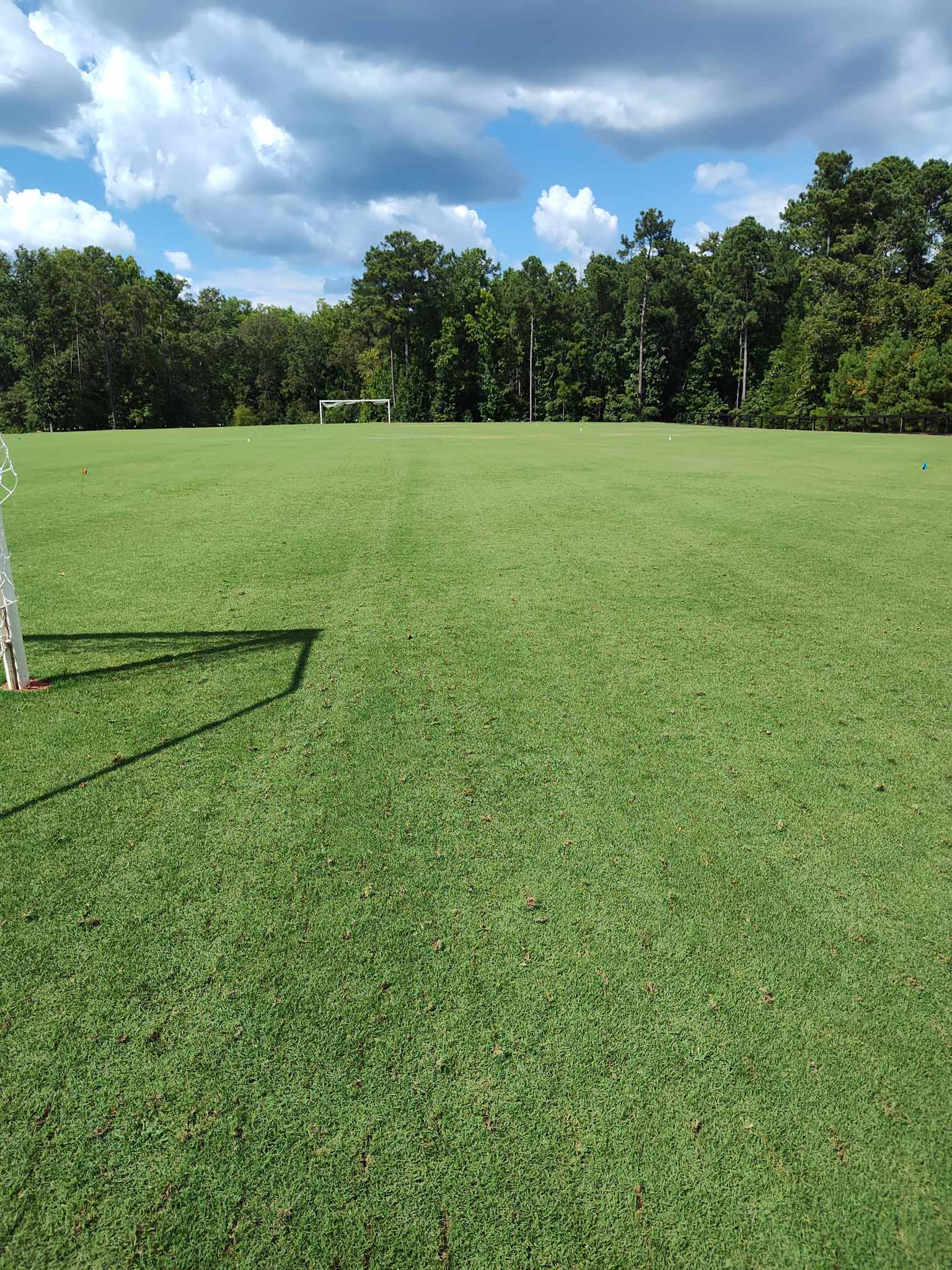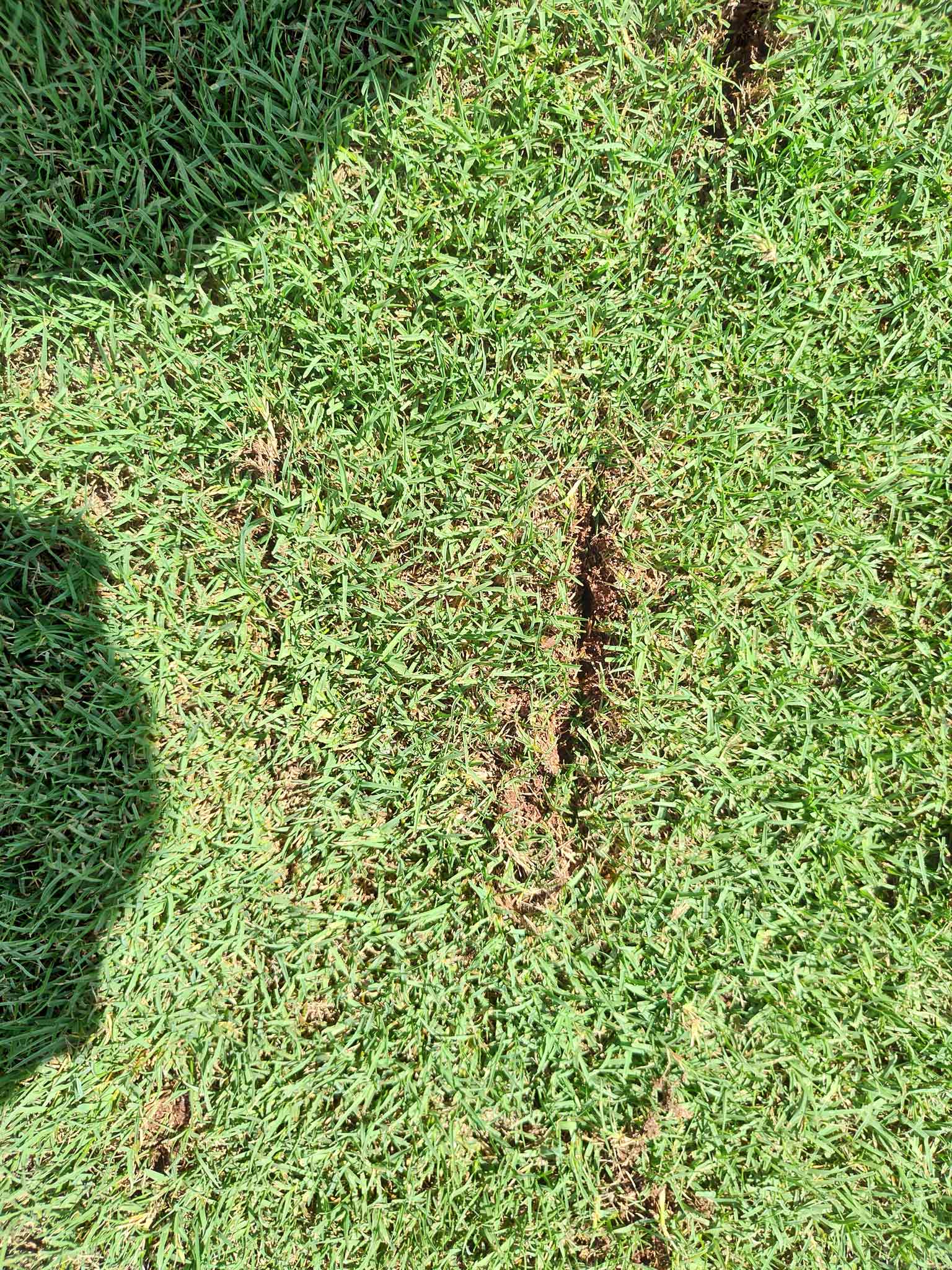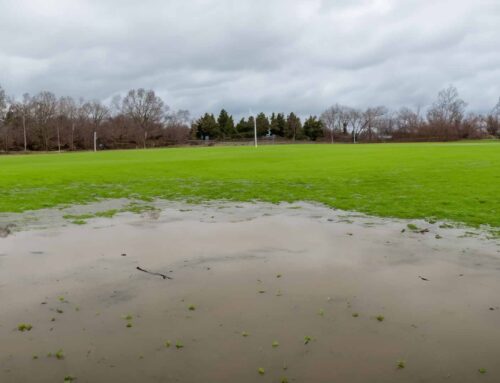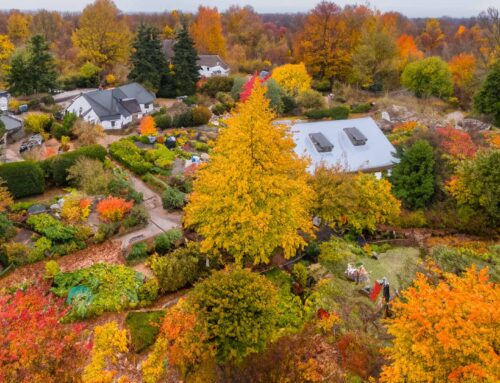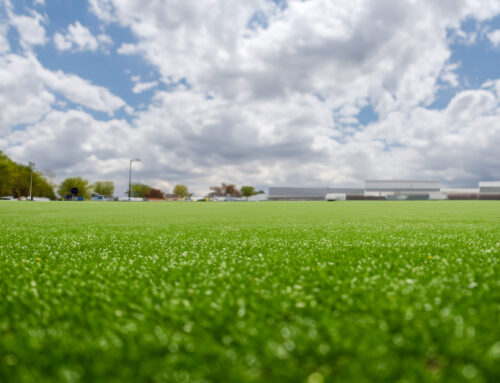The ROI of Aeration: From Corporate Campuses to Sports Fields
Studies show that aerated lawns can absorb up to 50% more water than compacted lawns, significantly reducing runoff and ensuring that vital moisture reaches the roots. For facility managers, executives, and operations managers overseeing corporate or industrial properties, aeration offers a cost-effective way to enhance the aesthetic appeal and longevity of your landscapes, providing a substantial return on investment. Similarly, athletic directors, headmasters, and school presidents can benefit from this practice to maintain top-quality sports fields and school grounds. Real Estate leasing agents will find that aeration enhances the value of commercial properties, while DIY homeowners can achieve professional-level results for larger projects and landscape issues.
In this article, we explore how lawn aeration serves as a crucial practice for enhancing lawn health and appearance across various property types, from corporate campuses to sports fields, offering significant returns on investment.
Direct Benefits of Lawn Aeration in Georgia: Improve Grass Health and Soil Quality
Aeration is a simple yet vital process for maintaining healthy and vibrant lawns in Georgia. It involves creating small holes in the soil to allow better access for air, water, and nutrients to reach the grass roots. This helps relieve soil compaction, which can be caused by heavy foot traffic and machinery. By reducing compaction, aeration encourages root growth and improves water infiltration, making lawns more resilient and better at absorbing water. This reduces surface runoff and prevents puddles and waterlogging.
Aeration is a key maintenance practice, and its effectiveness is highly dependent on soil moisture. In dry conditions, the aerator tines may struggle to penetrate the soil, so it’s advisable to water the lawn thoroughly a few days before aerating. However, avoid aerating when the soil is too wet, as this can cause soil plugs to stick in the tines and the aerator to tear up the ground by getting stuck or leaving ruts. The ideal time for aerating warm season grasses is from late spring to late summer, aligning with the lawn’s active growth period, which enhances the benefits of improved soil aeration. Ideal times for cool season grasses are in the fall and early spring when those grasses are actively growing. Aerations when the turf is dormant or slowly growing can actually be detrimental since the turf cannot recover as quickly and can lead to increased weeds.
Additionally, aeration increases air exchange, providing oxygen to beneficial soil microbes that aid in nutrient uptake. It also helps control thatch buildup, ensuring a balanced layer of organic material for optimal turf health. For a more in-depth look at these benefits and the different types of aeration, check out our previous article, “Essential Practice For Top-Performing Athletic Fields: Aeration.“
Aeration ROI: How Lawn Care Investment Pays Off
Enhanced Nutrient Uptake
Improved Nutrient Absorption: Aeration facilitates better absorption of essential nutrients from fertilizers, leading to a 20-30% increase in nutrient uptake by the lawn compared to non-aerated lawns.
Decreased Need for Fertilizers and Chemicals
More efficient nutrient absorption means property managers can use less fertilizer, lowering costs for lawn care products. Additionally, healthy turf requires fewer chemical treatments for pests, weeds, and disease control.
Microbial Activity: Studies indicate that aerated soils support a 15-20% increase in beneficial microbial activity, which aids in breaking down organic matter and releasing nutrients.
Increased Thatch Breakdown
Thatch Management: Aeration reduces thatch buildup by up to 50%, allowing water, air, and nutrients to penetrate the soil more effectively. This contributes to a healthier lawn ecosystem and reduces the risk of pest infestations.
Cost Savings on Watering
Water Efficiency: With aeration, lawns require approximately 30% less water due to improved soil structure and moisture retention. This can result in significant savings on water bills, especially during the hot, dry months typical in LaGrange, Georgia.
Drought Resistance: Aerated lawns develop deeper and more extensive root systems, enhancing their ability to withstand drought conditions. Lawns with robust root systems are less likely to show stress during dry spells and recover quicker from drought.
Enhanced Turf Density
Increased Turf Density: Regular aeration can lead to a 15-25% increase in turf density. A denser lawn not only looks better but also helps the turf outcompete weeds.
Faster Recovery: Aerated lawns recover more quickly from stress and damage, due to a more extensive root system.
Economic and Market Impact of Lawn Aeration
Enhanced Property Value and Curb Appeal
Aeration plays a vital role in maintaining healthy and vibrant lawns, which not only enhance the overall appearance but also create a welcoming and professional environment for employees, clients, and visitors. According to the National Association of Realtors (NAR), well-kept landscapes can boost property values by 5-15%. For corporate campuses, this improvement in curb appeal can enhance the company’s image, reflecting positively on the business and contributing to a positive first impression.
Reduced Maintenance Costs
For corporate campus facilities managers, efficient budget management is crucial. While it’s true that aeration adds to the upfront maintenance costs, its long-term benefits make it a smart investment. Regular aeration improves lawn health, leading to a stronger, more resilient lawn that can reduce the need for emergency treatments, frequent repairs, and even excessive water use. Healthier lawns require fewer chemical treatments and can optimize water absorption, leading to potential savings of up to 15-20% on overall lawn care costs over time. Although aeration may not reduce the number of maintenance visits, the enhanced lawn health can prevent costly interventions, ultimately making it a cost-effective choice for corporate facilities.
Enhanced Employee and Visitor Experience
A well-maintained landscape can greatly enhance the experience of employees and visitors. Lush, green lawns create a pleasant and inviting atmosphere, which can contribute to employee satisfaction and well-being. Additionally, well-kept grounds can impress clients and stakeholders, reinforcing the company’s commitment to quality and attention to detail. This positive perception can indirectly contribute to employee retention and client relationships, offering intangible but valuable benefits.
Environmental and Sustainability Considerations
Aeration not only improves the appearance and health of lawns but also plays a crucial role in supporting sustainability goals. By promoting better water absorption and reducing runoff, aeration aids in water conservation efforts, which is especially beneficial for corporate campuses and properties focused on eco-friendly practices. Improved water retention reduces the risk of erosion and chemical leaching into local water systems, making aeration an essential part of sustainable landscape management.
For companies looking to align with corporate social responsibility (CSR) initiatives, aeration offers an opportunity to enhance their environmental efforts. Facilities managers can highlight these sustainability practices, showcasing the company’s commitment to water conservation and eco-conscious operations.
In addition to water conservation, a well-aerated, properly maintained lawn contributes positively to carbon sequestration. Lawns with dense canopies and robust root systems capture and store carbon in the soil, which helps offset environmental concerns about large turf areas. By improving soil structure and enhancing its ability to retain carbon, aeration plays a vital role in maintaining a healthy, sustainable landscape that aligns with broader environmental goals. This not only enhances the property’s sustainability profile but also contributes to long-term ecological health.
Marketability and Competitive Advantage
A well-maintained corporate campus can enhance the marketability of the property, making it more attractive to potential tenants or buyers if the property is leased or sold. The investment in aeration can provide a competitive edge in the real estate market, as companies often seek properties with high-quality outdoor spaces. This competitive advantage not only increases property value but also ensures that the corporate campus stands out as a desirable location for businesses and organizations.
Long-Term Savings: Lawn Longevity and Maintenance Savings
Extended Lawn Lifespan: Regular aeration can extend the lifespan of your lawn by 30-50%, reducing the frequency and cost of re-sodding or reseeding.
Reduced Repair Costs: Lawns that are aerated regularly experience 20-25% fewer issues related to soil compaction and poor drainage, leading to lower repair costs over time.
Energy Savings
Lower Cooling Costs: A healthy, dense lawn can lower ambient temperatures around your home, reducing cooling costs by 10-15% during hot summers. Aeration contributes to this by promoting a robust lawn that effectively insulates against heat.
For properties with outdoor areas, this can mean reduced cooling costs for buildings and improved comfort for occupants, contributing to better productivity and satisfaction.
Conclusion: Maximizing ROI with Lasting Lawn Health
Return on Investment (ROI): The initial investment in aeration is relatively modest compared to the substantial long-term benefits it provides. For commercial properties, aeration can result in a 200-300% return on investment. This ROI is achieved through several key factors: enhanced lawn health leading to reduced maintenance and repair costs, decreased water usage, and the increased property value that comes with a well-maintained and visually appealing landscape.
Investing in aeration not only ensures a lush and healthy lawn but also contributes to significant cost savings and increased asset value, making it a smart and financially sound decision for commercial facility managers.
After Slit Aeration
Ready to enhance your property’s landscape and see the benefits for yourself? Contact us today to schedule a free consultation and receive a personalized quote. Let our experts help you maximize the return on your investment with professional aeration services.

